Analysis and Evaluation of Load-Carrying Capacity of CFRP-Reinforced Steel Structures
Abstract
1. Introduction
2. Materials and Methodology
2.1. Materials and Fabrication of the Specimens
2.2. Load-Carrying Test Trial
3. Results and Discussion
3.1. Specimen Design
3.2. Analysis of Experimental Data from Three-Point Bending Tests
3.3. Comparison of the Influential Factor of the Load-Carrying
4. Load-Carrying Capacity Evaluation
4.1. Finite Element Analysis of the CFRP-Reinforced Steel Beam
4.1.1. Selection of Unit Type
- Steel Beam
- 2.
- CFRP Plate
- 3.
- Adhesive Layer
4.1.2. Grid Division
4.1.3. Boundary Conditions
4.1.4. Comparison of Numerical Analysis and Experimental Results
4.2. Establishment of Dataset Based on FEA Analysis
4.3. Establishment of Prediction Model of Load-Carrying Capacity of CFRP Reinforced Steel Beams
4.4. Validation of Load-Carrying Capacity Prediction Model for CFRP Reinforced Steel Beams
5. Conclusions
- It is analyzed that the reinforcement interval has the greatest influence on the load-carrying capacity of CFRP-reinforced steel beams, followed by the number of CFRP layers, and the thickness of the adhesive layer had the lowest influence. Their F-values were calculated to be 5.010, 2.33, and 0.863, respectively.
- The prediction model for the load-carrying capacity of CFRP-reinforced steel beams is established based on the random forest algorithm with small datasets. The MAE and RMSE values of the prediction model were verified to be 0.12 and 0.25, respectively, which prove the effectiveness of the prediction algorithm.
- The use of a validated FEA model to build the dataset for the prediction algorithm of load-carrying capacity effectively saves spending on experiments.
Author Contributions
Funding
Institutional Review Board Statement
Informed Consent Statement
Data Availability Statement
Conflicts of Interest
References
- Ban, H. A review of research on high-strength steel structures. Proc. Inst. Civ. Eng. Struct. Build. 2018, 171, 625–641. [Google Scholar] [CrossRef]
- Pawlak, A.M.; Górny, T.; Dopierała, Ł.; Paczos, P. The Use of CFRP for Structural Reinforcement—Literature Review. Metals 2022, 9, 1470. [Google Scholar] [CrossRef]
- Moghadam, D.M.; Fathi, A.; Chaallal, O. Retrofitting of Steel Structures with CFRP: Literature Review and Research Needs. Appl. Sci. 2024, 14, 5958. [Google Scholar] [CrossRef]
- Elkhabeery, O.H.; Safar, S.S.; Mourad, S.A. Flexural strength of steel I-beams reinforced with CFRP sheets at tension flange. J. Constr. Steel Res. 2018, 148, 572–588. [Google Scholar] [CrossRef]
- Bastani, A.; Das, S.; Kenno, S. Rehabilitation of thin walled steel beams using CFRP fabric. Thin Walled Struct. 2019, 143, 106215. [Google Scholar] [CrossRef]
- Kypriadis Minos, E.; Bilalis Elias, P.; Tsouvalis Nicholas, G. Experimental and numerical study of CFRP reinforced steel beams. Proc. Inst. Mech. Eng. Part M J. Eng. Marit. Environ. 2021, 4, 931–943. [Google Scholar] [CrossRef]
- Chen, Z.; Xu, W.; Zhou, J. Mechanical performance of marine concrete filled CFRP-aluminum alloy tube columns under axial compression: Experiment and finite element analysis. Eng. Struct. 2022, 272, 114993. [Google Scholar] [CrossRef]
- Han, X.; Li, D.; Sun, L.; Wang, D.; Xu, J.; Zhang, W. Effect of bondline thickness on the mechanical performance of CFRP laminate with asymmetric damage repaired by double-sided adhesive patch. Thin Walled Struct. 2024, 201, 111976. [Google Scholar] [CrossRef]
- Mojtabaei, S.M.; Becque, J.; Hajirasouliha, I.; Khandan, R. Predicting the buckling behaviour of thin-walled structural elements using machine learning methods. Thin Walled Struct. 2023, 184, 110518. [Google Scholar] [CrossRef]
- Nasrollahzadeh, K.; Basiri, M.M. Prediction of shear strength of FRP reinforced concrete beams using fuzzy inference system. Expert Syst. Appl. 2014, 4, 1006–1020. [Google Scholar] [CrossRef]
- Truong, G.T.; Hwang, H.J.; Kim, C.S. Assessment of punching shear strength of FRP-RC slab-column connections using machine learning algorithms. Eng. Struct. 2022, 255, 113898. [Google Scholar] [CrossRef]
- Tran, V.L.; Kim, S.E. A practical ANN model for predicting the PSS of two-way reinforced concrete slabs. Eng. Comput. 2020, 3, 1–25. [Google Scholar] [CrossRef]
- Khan, K.; Iqbal, M.; Salami, B.A.; Amin, M.N.; Ahamd, I.; Alabdullah, A.A.; Arab, A.M.A.; Jalal, F.E. Estimating Flexural Strength of FRP Reinforced Beam Using Artificial Neural Network and Random Forest Prediction Models. Polymers 2022, 11, 2270. [Google Scholar] [CrossRef]
- Hu, H.; Wei, Q.; Wang, T.; Ma, Q.; Jin, P.; Pan, S.; Li, F.; Wang, S.; Yang, Y.; Li, Y. Experimental and Numerical Investigation Integrated with Machine Learning (ML) for the Prediction Strategy of DP590/CFRP Composite Laminates. Polymers 2024, 16, 1589. [Google Scholar] [CrossRef]
- Zhang, Y.; Zhang, F.; Wu, L.; Han, H.Z.; Wu, Y.F. Flexural capacity design model of reinforced concrete beams strengthened with hybrid bonded CFRP. Eng. Struct. 2024, 319, 118822. [Google Scholar] [CrossRef]
- ASTM D7264M-21; American Society for Testing and Material International, Standard Test Method for Flexural Properties of Polymer Matrix Composite Materials. ASTM International: West Conshohocken, PA, USA, 2021.
- Xie, J.; Xi, R.; Tong, C.; Yan, J.B. Mechanical properties of Q235~Q460 mild steels at low temperatures. Constr. Build. Mater. 2023, 363, 129850. [Google Scholar] [CrossRef]
- Bakar, M.B.C.; Rashid, R.S.M.; Amran, M.; Jaafar, M.S. Evaluation of the bond-dependent factors for CFRP bars used as structural reinforcement: A critical review. Case Stud. Constr. Mater. 2023, 18, e02064. [Google Scholar] [CrossRef]
- Hawileh, R.A.; Salama, A.S.D.; Mhanna, H.H.; Assad, M.; Abdalla, J.A.; Saqan, E.I. Flexural behavior of RC beams externally strengthened with side-bonded CFRP laminates with variable internal reinforcement. Eng. Struct. 2024, 318, 118707. [Google Scholar] [CrossRef]
- Hedayat, A.; Sloane, N.J.A.; Stufken, J. Orthogonal Arrays: Theory and Applications; Springer: Berlin/Heidelberg, Germany, 1999. [Google Scholar]
- Adams, M.B. Design and Analysis of Experiments, Sixth Edition. J. Qual. Technol. 2005, 37, 175–176. [Google Scholar] [CrossRef]
- Jiao, H.; Wu, Y.; Guo, X.; Wang, S.; Jiang, L.; Wang, S.; Hao, L.; Tan, G. Optimization of V-Ti-Fe hydrogen storage alloy based on orthogonal experiments. J. Alloys Compd. 2024, 1002, 175262. [Google Scholar] [CrossRef]
- Iu, C.K.; Bradford, M.A. Second-order elastic finite element analysis of steel structures using a single element per member. Eng. Struct. 2010, 9, 2606–2616. [Google Scholar] [CrossRef]
- Li, Y.; Mei, K.; Wang, Y.; Jia, W.; Sun, S. Finite element model analysis of long-term performance of composite anchorage based on double-material parameters. J. Build. Eng. 2024, 87, 87109059. [Google Scholar] [CrossRef]
- Kaware, K.; Kotambkar, M.; Sontakkey, A.; Talekar, N. Finite element analysis of CFRP composite under low velocity impact to improve the impact strength. Int. J. Crash Worthiness 2023, 28, 717–731. [Google Scholar] [CrossRef]
- Shimizu, S.; Sato, M.; Koyanagi, J.; Suemasu, H.; Kogo, Y. Numerical simulation of compressive failure of carbon-fiber-reinforced plastic laminates with various hole shapes. Adv. Compos. Mater. 2021, 30, 58–75. [Google Scholar] [CrossRef]
- Luo, B.; Xue, L.; Wang, Q.; Zou, P. Mechanistic Study of Failure in CFRP Hybrid Bonded–Bolted Interference Connection Structures under Tensile Loading. Materials 2024, 17, 2117. [Google Scholar] [CrossRef]
- Haoliang, Z.; Yousong, W. Intelligent Analysis for Safety-Influencing Factors of Prestressed Steel Structures Based on Digital Twins and Random Forest. Metals 2022, 12, 646. [Google Scholar] [CrossRef]
- He, L.; Wang, Z.; Akebono, H.; Sugeta, A. Machine Learning-Based Predictions of Fatigue Life and Fatigue Limit for Steels. J. Mater. Sci. Technol. 2021, 90, 9–19. [Google Scholar] [CrossRef]
- Chen, S.Z.; Feng, D.C.; Han, W.S.; Wu, G. Development of data-driven prediction model for CFRP-steel bond strength by implementing ensemble learning algorithms. Constr. Build. Mater. 2021, 303, 124470. [Google Scholar] [CrossRef]
- Chen, H.; Qian, C.; Liang, C.; Kang, W. An approach for predicting the compressive strength of cement-based materials exposed to sulfate attack. PLoS ONE 2018, 13, e0191370. [Google Scholar] [CrossRef]
- Liu, Y.; Wu, Q.; Wang, P.; Zhuang, W. Forming process prediction of a self-piercing riveted joint in carbon fibre reinforced composites and aluminium alloy based on deep learning. J. Manuf. Process. 2023, 106, 453–464. [Google Scholar] [CrossRef]
- Rahman, J.; Ahmed, K.S.; Khan, N.I.; Islam, K.; Mangalathu, S. Data-driven shear strength prediction of steel fiber reinforced concrete beams using machine learning approach. Eng. Struct. 2021, 233, 111743. [Google Scholar] [CrossRef]
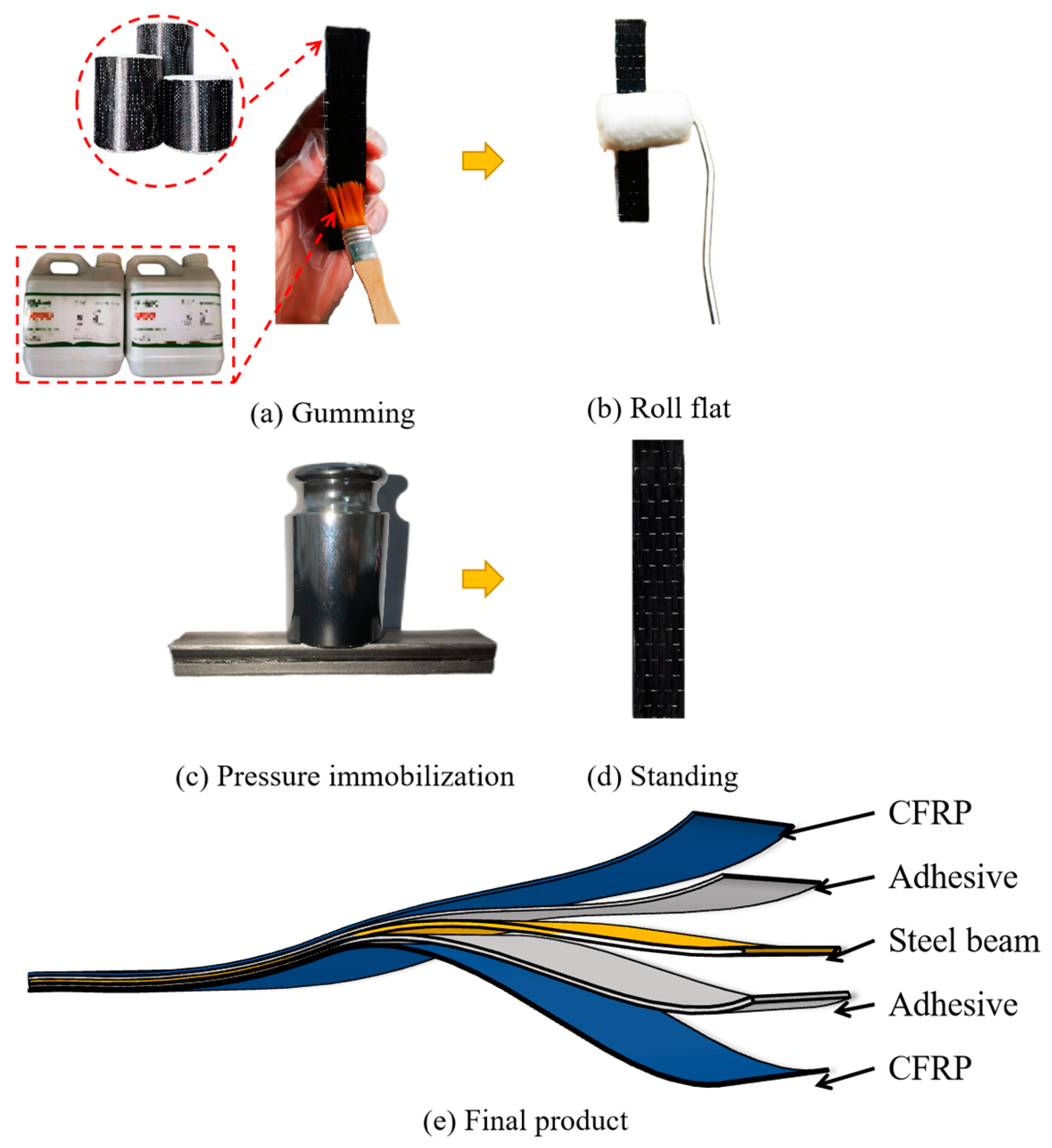

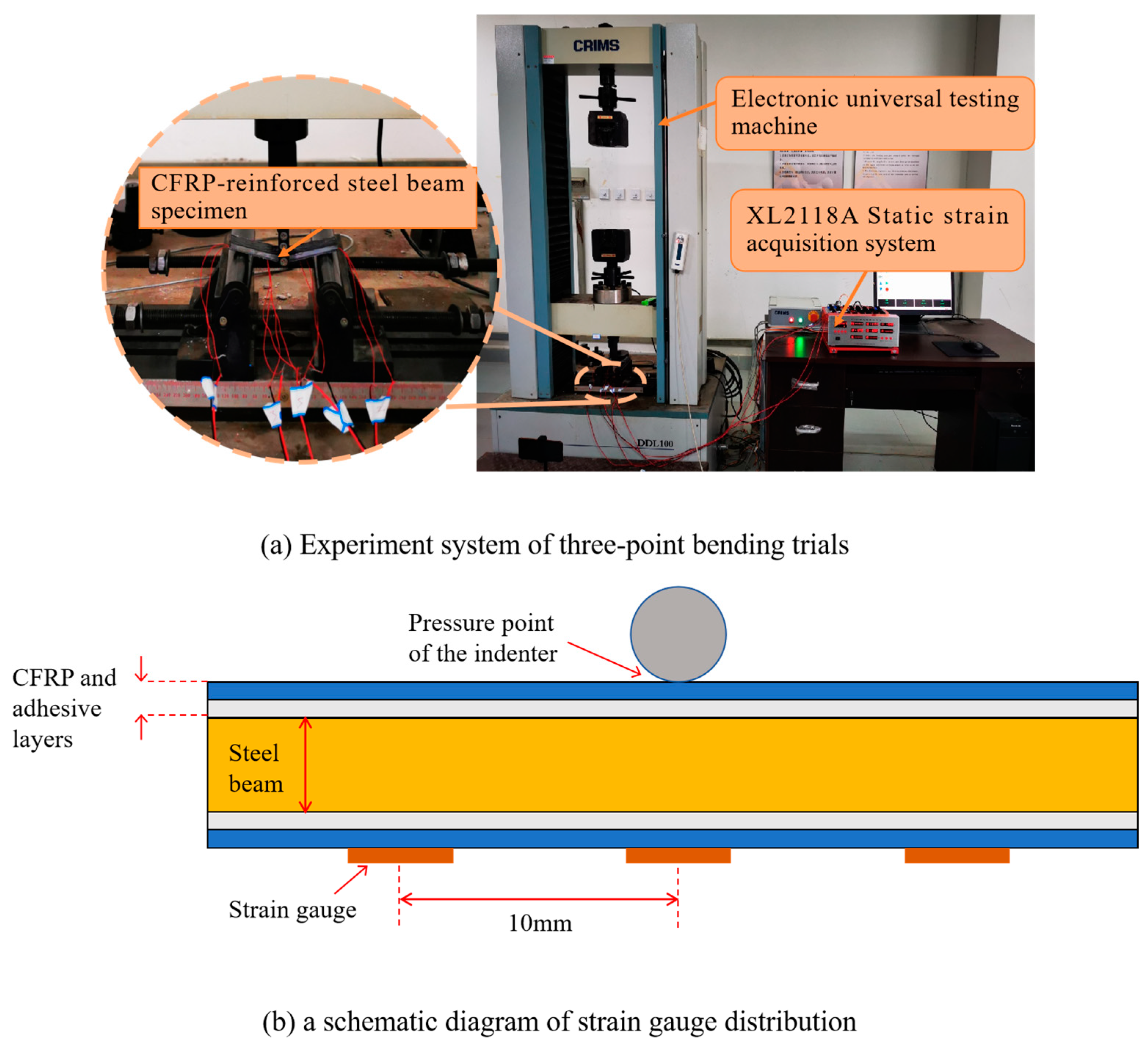
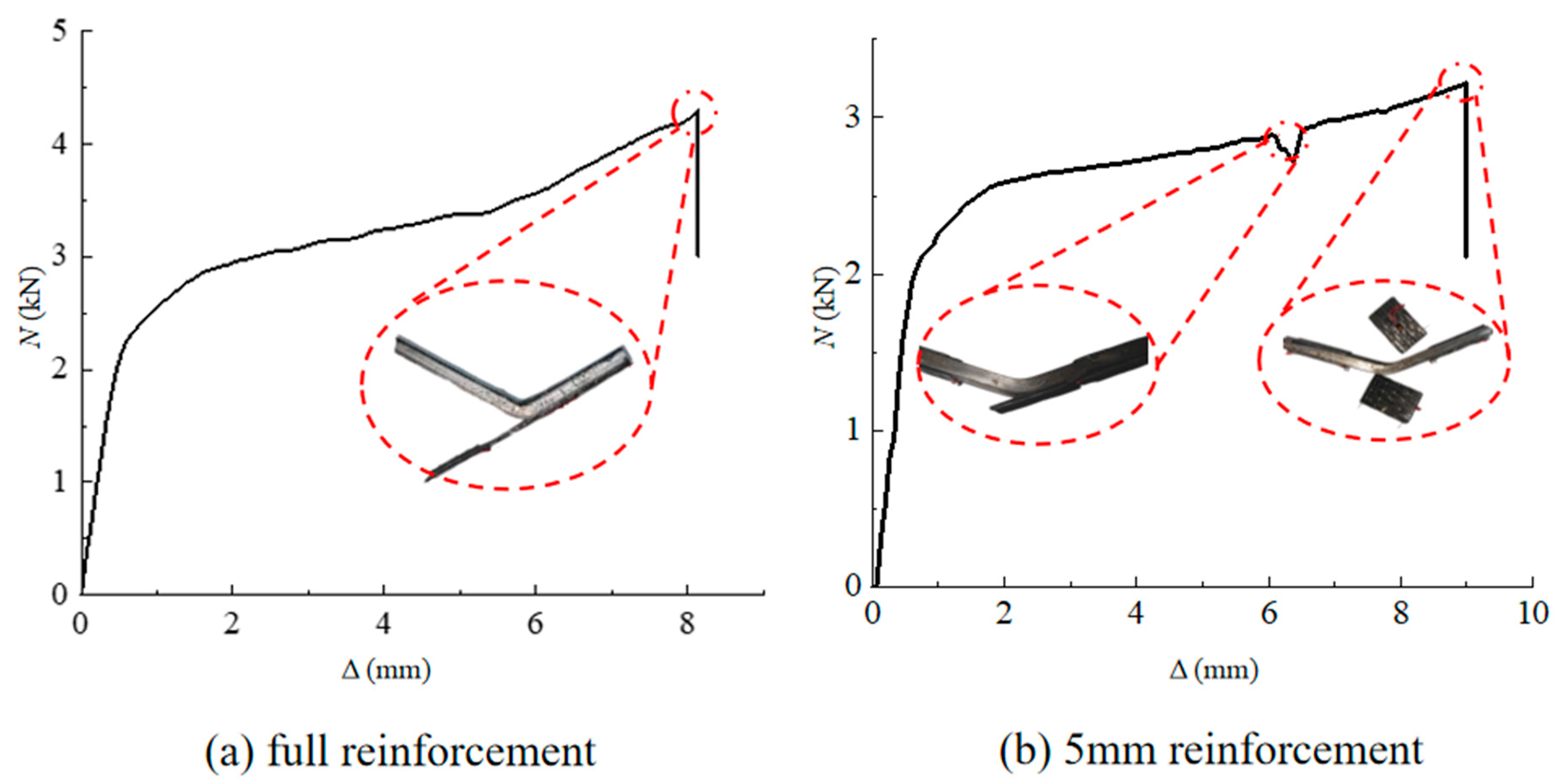
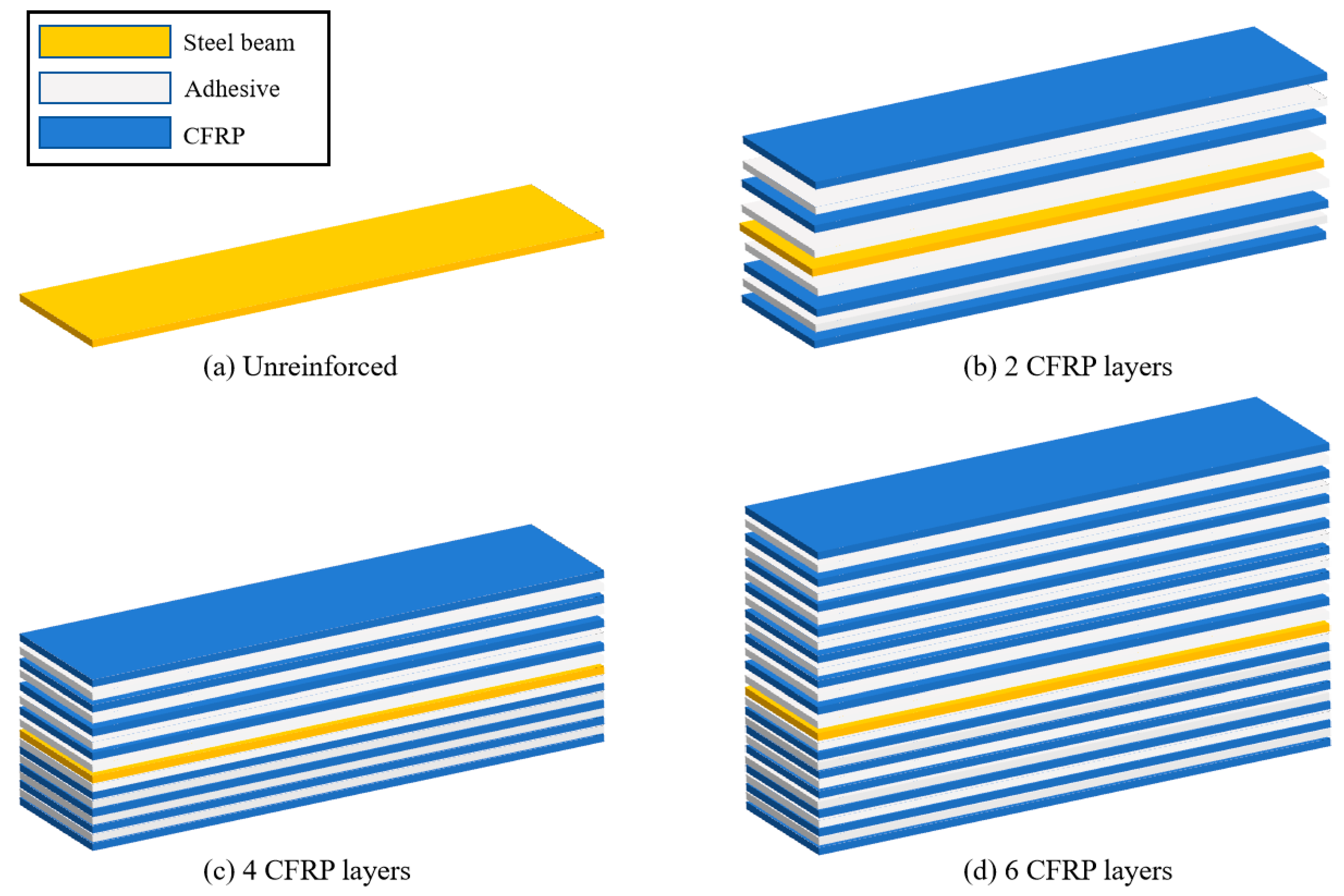

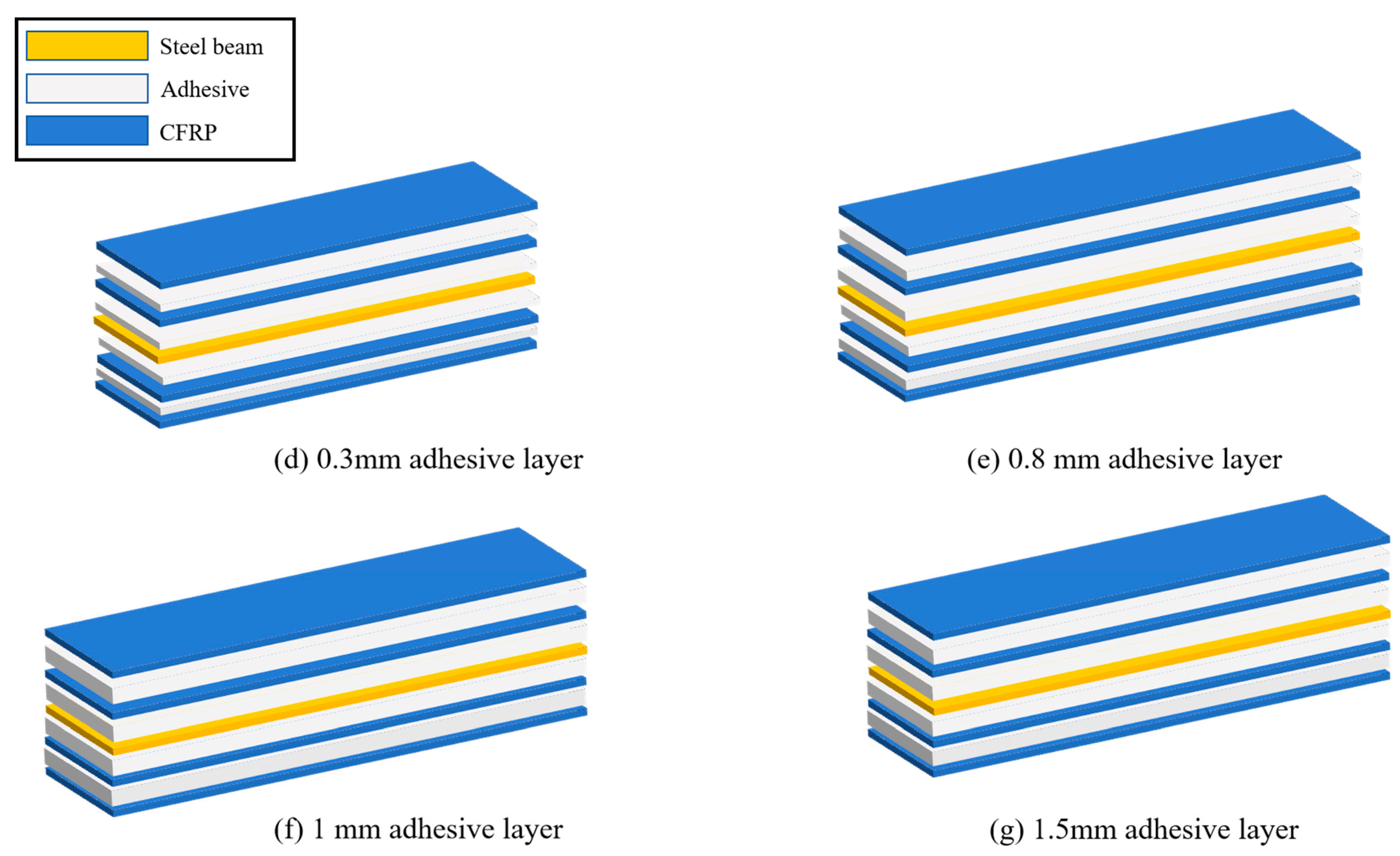



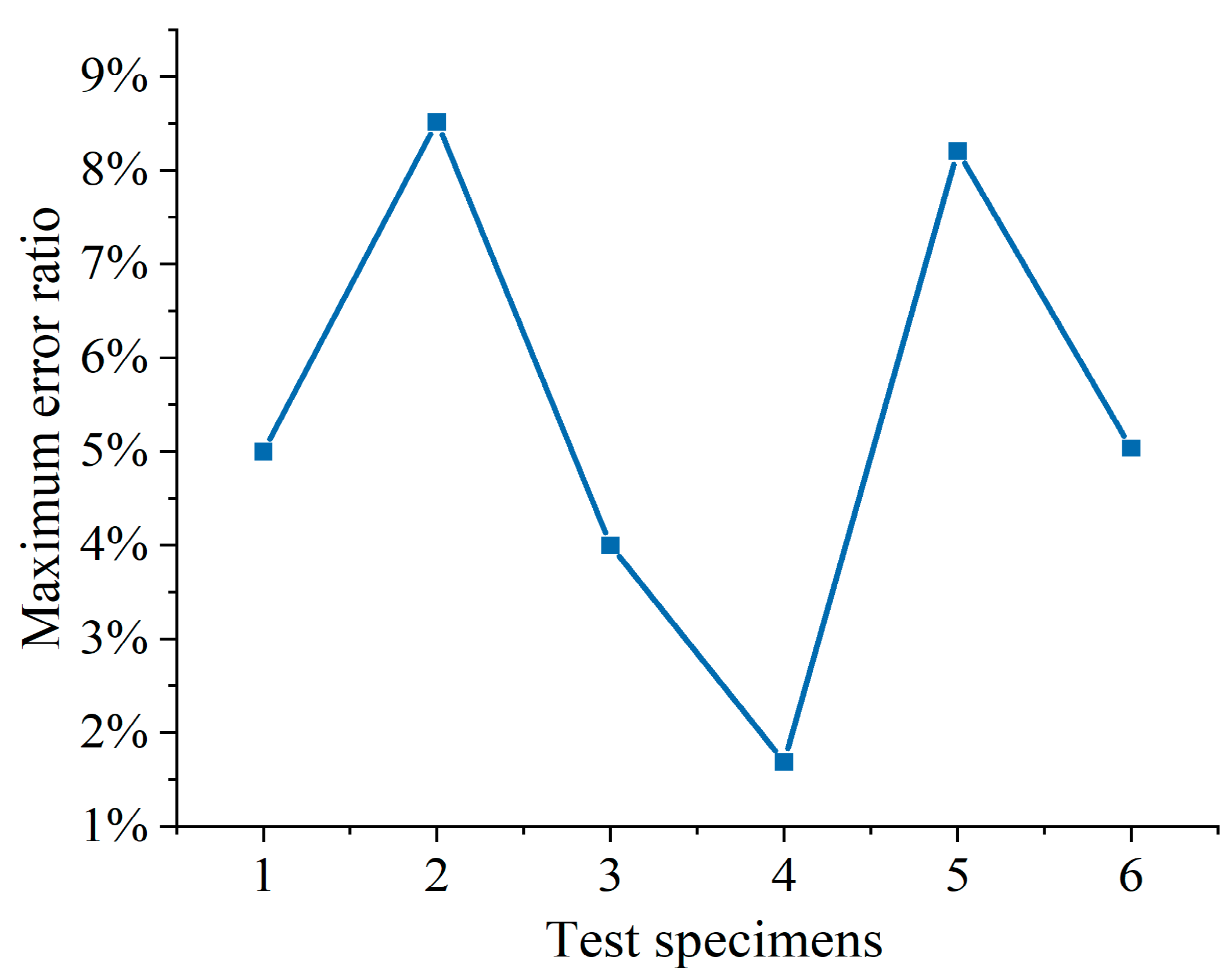
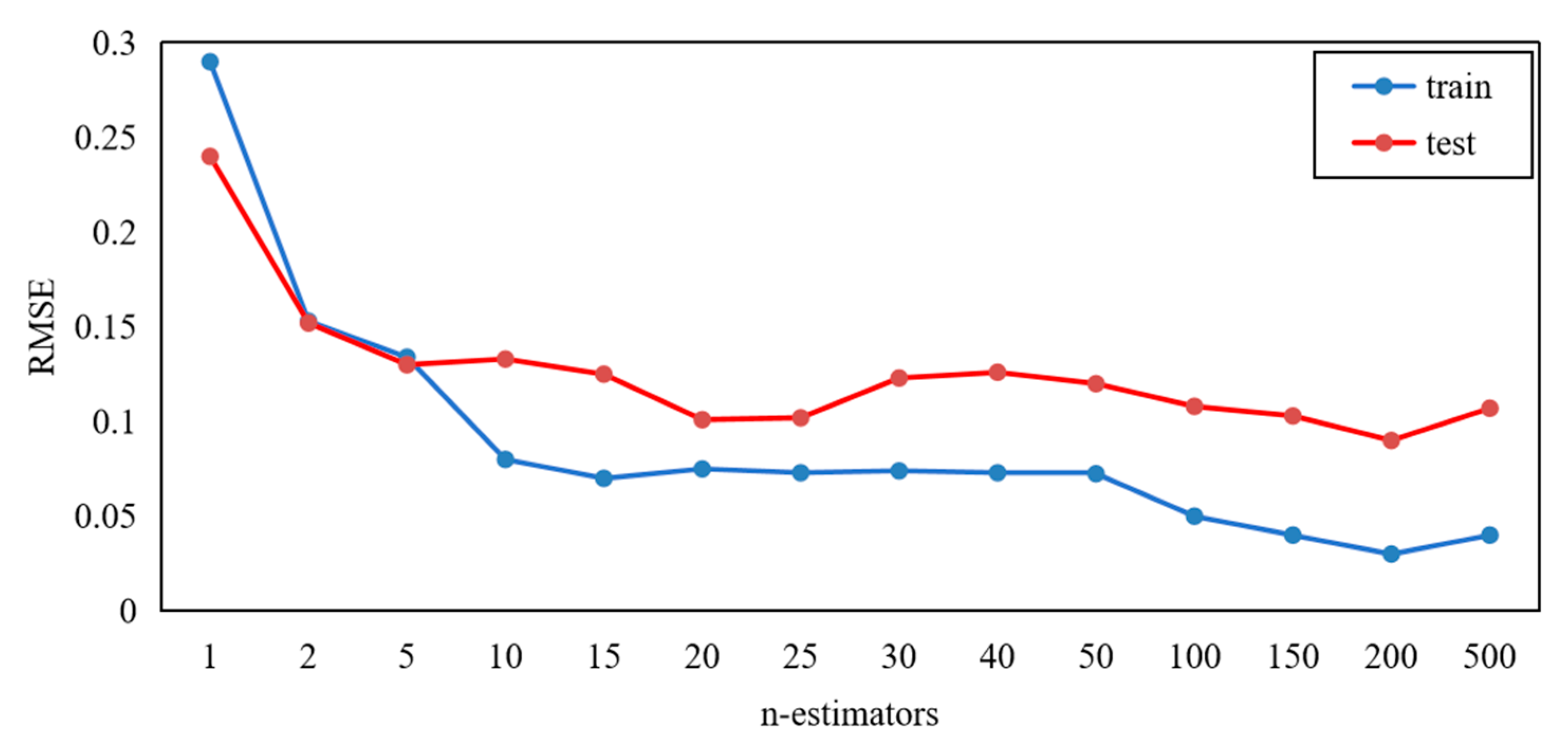

| Components of Specimen | Parameters |
|---|---|
| Steel beam | Material: Q235 Long: 120 mm wide: 20 mm thickness: 6 mm |
| CFRP layer | Material: 37 12 k carbon fiber filaments thickness: 1 mm |
| Adhesive layer | Bending strength: 90.8 MPa Compressive strength: 89.5 MPa |
| CFRP Layers | Reinforcement Interval (mm) | Thickness of Adhesive Layer (mm) | Load-Carrying Capacity (kN) |
|---|---|---|---|
| 2 | 0 | 0.3 | 4.082 |
| 2 | 5 | 1 | 4.120 |
| 2 | 10 | 0.8 | 3.512 |
| 4 | 0 | 1 | 4.446 |
| 4 | 5 | 0.8 | 3.736 |
| 4 | 10 | 0.3 | 3.733 |
| 6 | 0 | 0.8 | 4.852 |
| 6 | 5 | 0.3 | 4.120 |
| 6 | 10 | 1 | 4.100 |
| Item. | CFRP Layers | Reinforcement Interval | Thickness of the Adhesive Layer |
|---|---|---|---|
| K1 | 11.714 | 13.380 | 11.935 |
| K2 | 11.915 | 11.976 | 12.100 |
| K3 | 13.072 | 11.345 | 12.666 |
| k1 | 3.905 | 4.460 | 3.979 |
| k2 | 3.972 | 3.992 | 4.033 |
| k3 | 4.357 | 3.782 | 4.222 |
| Range | 0.453 | 0.678 | 0.244 |
| Source of Variance | Sum of Squares of Deviations | Degree of Freedom | Mean Square | F-Value | p-Value |
|---|---|---|---|---|---|
| CFRP layers | 0.332 | 2 | 0.166 | 2.34 | 0.299 |
| Reinforcement interval | 0.711 | 2 | 0.356 | 5.011 | 0.166 |
| Thickness of adhesive layer | 0.124 | 2 | 0.061 | 0.863 | 0.537 |
| Thickness of Steel Beams (mm) | Interval (mm) | Number of CFRP Layers | Adhesive Layer (mm) | Force (kN) | Increase (%) |
|---|---|---|---|---|---|
| 6 | 0 | 2 | 0.30 | 4.08 | 36.07 |
| 6 | 0 | 2 | 0.50 | 4.11 | 37.00 |
| 6 | 0 | 2 | 0.80 | 4.14 | 38.00 |
| 6 | 0 | 2 | 1.00 | 4.30 | 43.33 |
| 6 | 0 | 2 | 1.50 | 4.29 | 43.00 |
| 6 | 0 | 4 | 0.30 | 4.30 | 43.23 |
| 6 | 0 | 4 | 0.80 | 4.36 | 45.27 |
| 6 | 0 | 4 | 1.00 | 4.45 | 48.20 |
| 6 | 0 | 4 | 1.50 | 4.31 | 43.60 |
| 6 | 0 | 6 | 0.30 | 4.53 | 51.10 |
| 6 | 0 | 6 | 0.80 | 4.85 | 61.73 |
| 6 | 0 | 6 | 1.00 | 4.40 | 46.67 |
| 6 | 5 | 2 | 0.30 | 3.38 | 12.50 |
| 6 | 5 | 2 | 0.80 | 3.64 | 21.20 |
| 6 | 5 | 2 | 1.00 | 4.10 | 36.67 |
| 6 | 5 | 4 | 0.30 | 3.92 | 30.80 |
| 6 | 5 | 4 | 0.80 | 3.74 | 24.53 |
| 6 | 5 | 4 | 1.00 | 4.20 | 40.00 |
| 6 | 5 | 6 | 1.00 | 4.30 | 43.33 |
| 6 | 10 | 2 | 0.30 | 3.26 | 8.53 |
| 6 | 10 | 2 | 0.80 | 3.51 | 17.07 |
| 6 | 10 | 2 | 1.00 | 3.90 | 30.00 |
| 6 | 10 | 4 | 0.30 | 3.73 | 24.43 |
| 6 | 10 | 4 | 0.80 | 3.63 | 21.00 |
| 6 | 10 | 4 | 1.00 | 4.00 | 33.33 |
| 6 | 10 | 6 | 1.00 | 4.10 | 36.67 |
| 6 | 15 | 2 | 0.30 | 3.22 | 7.40 |
| 6 | 15 | 2 | 0.80 | 3.35 | 11.77 |
| 6 | 15 | 2 | 1.00 | 3.75 | 25.00 |
| 6 | 15 | 4 | 0.30 | 3.72 | 23.90 |
| 6 | 15 | 4 | 0.80 | 3.46 | 15.33 |
| 6 | 15 | 4 | 1.00 | 3.83 | 27.67 |
| 6 | 15 | 6 | 1.00 | 3.90 | 30.00 |
| Evaluation Indicators | KNN | Decision Tree | Random Forest |
|---|---|---|---|
| MAE | 0.27 | 0.10 | 0.10 |
| RMSE | 0.34 | 0.12 | 0.11 |
| R2 | 0.18 | 0.79 | 0.90 |
Disclaimer/Publisher’s Note: The statements, opinions and data contained in all publications are solely those of the individual author(s) and contributor(s) and not of MDPI and/or the editor(s). MDPI and/or the editor(s) disclaim responsibility for any injury to people or property resulting from any ideas, methods, instructions or products referred to in the content. |
© 2024 by the authors. Licensee MDPI, Basel, Switzerland. This article is an open access article distributed under the terms and conditions of the Creative Commons Attribution (CC BY) license (https://creativecommons.org/licenses/by/4.0/).
Share and Cite
Zhao, J.; Huang, Y.; Gong, K.; Wen, Z.; Liu, S.; Hou, Y.; Hong, X.; Tong, X.; Shi, K.; Qu, Z. Analysis and Evaluation of Load-Carrying Capacity of CFRP-Reinforced Steel Structures. Polymers 2024, 16, 2678. https://doi.org/10.3390/polym16182678
Zhao J, Huang Y, Gong K, Wen Z, Liu S, Hou Y, Hong X, Tong X, Shi K, Qu Z. Analysis and Evaluation of Load-Carrying Capacity of CFRP-Reinforced Steel Structures. Polymers. 2024; 16(18):2678. https://doi.org/10.3390/polym16182678
Chicago/Turabian StyleZhao, Jian, Yongxing Huang, Kun Gong, Zhiguo Wen, Sinan Liu, Yanyan Hou, Xuewu Hong, Xuecheng Tong, Kai Shi, and Ziyi Qu. 2024. "Analysis and Evaluation of Load-Carrying Capacity of CFRP-Reinforced Steel Structures" Polymers 16, no. 18: 2678. https://doi.org/10.3390/polym16182678
APA StyleZhao, J., Huang, Y., Gong, K., Wen, Z., Liu, S., Hou, Y., Hong, X., Tong, X., Shi, K., & Qu, Z. (2024). Analysis and Evaluation of Load-Carrying Capacity of CFRP-Reinforced Steel Structures. Polymers, 16(18), 2678. https://doi.org/10.3390/polym16182678




